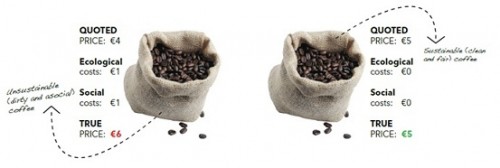
It strikes me that so many aging, i.e. retired people, attend sustainability conferences. Youngsters are present but mainly on behalf of their employers. Elderly people have been engaged in other sectors and now concentrate on sustainability issues. Quite enthusiastically. And quite knowledgeable. Not long ago, I talked to an oil engineer from Persia (the era of the shah, and that is long ago), who now sells solar technology. Interesting as a phenomenon, but besides the point of this column.
Once again, at the ‘True Pricing’ meeting, organized by Foreign Affairs in The Hague, there were many aging people. True Pricing is about calculating corporate results on the basis of true costs, i.e. taking into account ‘externalities’ (which we used to call environmental costs). A year ago, German sports shoe brand PUMA was the first company publishing such an annual account. Although, the first one?

Sustainable National Income
I am fortunate to have participated for some time in environmental discussions, and I remember Roefie Hueting (1929), a Dutch economist who in 1974 wrote a dissertation entitled ‘New Scarcity and Economic Growth’. He was the first one to indicate that corporate revenues are not realistic unless diminished with the environmental costs of its products. He also coined the term Sustainable National Income. Together with Jan Tinbergen, the first Nobel Prize winner for economy, he made a rough calculation of Sustainable World Income for the Rio 1992 conference. Credit where credit is due.
At Foreign Affairs, Reiner Hengstmann explained the True Pricing concept. Reiner is Global Director Safe Supply Chain for PUMA, and the man who thought it up and organized it for them. With all environmental costs taken into account, PUMA would have earned € 145 million less. Transparency and a better understanding were the main reasons for this exercise, Rainer said, ‘we now know where we stand’. He called the calculations a risk management and a transparency tool. It was not a Cradle-to-Cradle (C2C) exercise, as PUMA does not know exactly what its clients do with discarded shoes. But it is Cradle-to-Gate. Meaning: up to the moment when the product leaves the factory gate.
Excessive water use
Suppliers are responsible for by far the largest share of the environmental loss (€ 83 million). In this case, the number of suppliers exceeds 500. Particularly, excessive water use is the culprit. Not surprising, knowing that production of one pair of jeans requires 10.000 litres of water. Rainer also said that the result would even have been much higher if they had paid a fair wage to every producer of PUMA products. ‘We can achieve nothing on our own,’ he said, ‘but together with Adidas and Nike we might arrive at indexes for ecology and for labour in our sector.’
In the discussion, people appeared to be surprised that externalities could be compensated by raising the product’s price with 5%. To me, this does not seem to be something our rich western world could not carry. But then, I always had the impression that producers in these sectors earn more than they deserve, once they started producing in India and China, without letting us share the benefits of their doing so. And if we really talk true pricing, a few wage increases for workers in developing countries might be fair. But let us not press the issue. Environmental costs first. Roefie Hueting’s work was not about disadvantaged workers in the third world either.
www.puma.com
www.trueprice.org
www.worldconnectors.nl
www.idhsustainabletrade.com
www.ncdo.nl
www.sni-hueting.info
